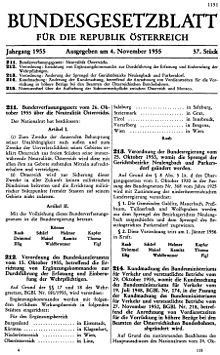- Declaration of Neutrality
-
History of Austria 
This article is part of a seriesEarly History Hallstatt culture Noricum Marcomanni Samo's Realm Carantania March of Austria Babenberger Privilegium Minus Habsburg era House of Habsburg Holy Roman Empire Archduchy of Austria Habsburg Monarchy Austrian Empire German Confederation Austria-Hungary World War I Assassination of Franz Ferdinand World War I Interwar Years German Austria First Republic of Austria Austrofascism/Federal State of Austria Anschluss World War II National Socialism World War II Post-war Austria Allied-occupied Austria Second Austrian Republic
Austria Portal
The Declaration of Neutrality was a declaration by the Austrian Parliament declaring the country permanently neutral. It was enacted on 26 October 1955 as a constitutional act of parliament, i.e., as part of the Constitution of Austria.
Formally, the declaration was promulgated voluntarily by the Republic of Austria. Politically, it was the direct consequence of the allied occupation by the Soviet Union, the United States, the United Kingdom and France between 1945 and 1955, from which the country was freed by the Austrian State Treaty of 15 May the same year. The Soviet Union would not have agreed to the State Treaty if Austria had not committed itself to declare its neutrality after the allied forces had left the country.[1]
Since 1955[2], neutrality has become a deeply ingrained element of Austrian identity. Austria's national holiday on 26 October commemorates the declaration. Legally, Austrian neutrality is both part of the Austrian constitution and of international law. There is an ongoing debate among legal scholars whether Austria could change this neutral status on its own account. This is a moot point, however, since there is no political or popular support for doing so.
References
- ^ K. Ginther, Neutralität und Neutralitätspolitik Die österreichische Neutralität zwischen Schweizer Muster und sowjetischer Koexistenzdoktrin, Vienna, 1975.
- ^ Bundesgesetzblatt für die Republik Österreich, 1955, http://de.wikipedia.org/wiki/Datei:Bundesgesetzblatt_(Austria)_1955_1151.jpg
- Rolf Steininger: Der Staatsvertrag. Österreich im Schatten von deutscher Frage und Kaltem Krieg 1938-1955, 2005, 198 p., (Publisher: StudienVerlag, Innsbruck-Wien-Bozen) - Summary in English
- Manfried Rauchensteiner: Stalinplatz 4. Österreich unter alliierter Besatzung, 2005, 336 p., (Publisher: Edition Steinbauer, Wien)
- The Federal Constitutional Law on the Neutrality of Austria in English
Categories:- Austrian law
- International law
- Politics of Austria
- History of Austria
- Foreign relations of Austria
- 1955 in Austria
- 1955 in international relations
- Military history of Austria
- Austria–Soviet Union relations
- Austria–United States relations
- Austrian history stubs
Wikimedia Foundation. 2010.

